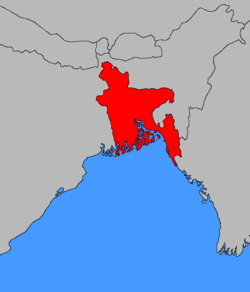East Pakistan
| East Pakistan | ||||||||||
|
পূর্ব পাকিস্তান مشرقی پاکستان |
||||||||||
| Former eastern wing of Pakistan | ||||||||||
|
||||||||||
| Capital | Dacca | |||||||||
| Languages |
Bengalia(official) English |
|||||||||
| Religion | Islam | |||||||||
| Government | Socialist state (1954–58) Presidential republic (1960–69) Military government (1969–71) |
|||||||||
| Administrator | ||||||||||
| • | 1960–1962 | Azam Khan | ||||||||
| • | 1962–1969 | Abdul Monem Khan | ||||||||
| • | 1969–1971 | Syed Mohammad Ahsan | ||||||||
| • | 1971 | Amir Abdullah Khan Niazi | ||||||||
| Chief Minister | ||||||||||
| • | 1955–1956, 1958 | Abu Hussain Sarkar | ||||||||
| • | 1956–1958 | Ataur Rahman Khan | ||||||||
| Governors | ||||||||||
| • | 1955–1956 | Amiruddin Ahmad | ||||||||
| • | 1956–1958 | A. K. Fazlul Huq | ||||||||
| • | 1958–1960 | Zakir Husain | ||||||||
| Legislature | Legislative Assembly | |||||||||
| Historical era | Cold War | |||||||||
| • | Established | 1955 | ||||||||
| • | Final settlement | 22 November 1954 | ||||||||
| • | Bangladesh Liberation War | 26 March 1971 | ||||||||
| • | Indo-Pakistani War | 3 December 1971 | ||||||||
| • | Surrender of Pakistan | 16 December 1971 | ||||||||
| Area | 147,570 km² (56,977 sq mi) | |||||||||
| Currency | Pakistani rupee | |||||||||
|
||||||||||
| Today part of |
|
|||||||||
| a. Second National Language - Dominion of Pakistan: 29 February 1956 | ||||||||||
East Pakistan (Bengali: পূর্ব পাকিস্তান Pūrbô Pākistān; Urdu: مشرقی پاکستان Mas̱ẖriqī Pākistān IPA: [məʃrɪqiː pɑːkɪst̪ɑːn]), present-day Bangladesh, was a provincial state of Pakistan that existed in the Bengal region of the northeast of South Asia from 1955 until 1971, following the One Unit programme that laid the existence of East Pakistan.
During the partition of India in 1947, the British Empire divided the region of Bengal into East and West Bengal, separating the eastern areas with a Muslim majority from the western areas with a Hindu majority.Inter-religious violence during the partition drove Bengali Muslims and Hindus further apart, leading to political upheaval in Bengal. In 1947, districts of Bengal with a Muslim majority favoured division after approving the 3 June Plan presented by the Viceroy of India Lord Mountbatten, and merged with the new province of East Bengal of the Dominion of Pakistan. From 1947 until 1954, East Bengal was an independent administrative unit which was governed by the Pakistan Muslim League led by Nurul Amin. In 1955, the Bengali Prime minister Muhammad Ali Bogra devolved the province of East Bengal and established the state of East Pakistan with Dhaka as its state capital. In the 1954 elections the Pakistan Muslim League were completely defeated by the United Front coalition of the Awami League, the Krishak Praja Party, the Democratic Party and Nizam-e-Islam. The Awami League gained the control of East Pakistan after appointing Huseyn Suhrawardy for the office of prime minister. This authoritarian period that existed from 1958 until 1971, is often regarded as period of mass repression, resentment, and political neglect and ignorance. Allying with the population of West Pakistan, the East's population unanimously voted for Fatima Jinnah during the 1965 presidential elections against Ayub Khan. The elections were widely believed to be heavily rigged in the favour of Ayub Khan using state patronage and intimidation to influence the indirectly elected electoral college. The economic disparity, impression that West Pakistan, despite being less populated than East Pakistan, was ruling and prospering at its cost further popularize the Bengali nationalism. The support for state autonomy grew when the Awami League introduced the Six point movement in 1966, and participated with full force in the 1970 general elections in which the Awami League had won and secured the exclusive mandate of East-Pakistan.
...
Wikipedia

